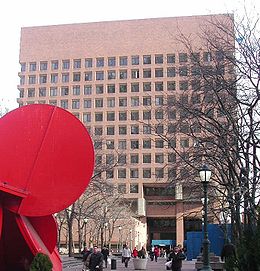
Plop art
Encyclopedia

Slang
Slang is the use of informal words and expressions that are not considered standard in the speaker's language or dialect but are considered more acceptable when used socially. Slang is often to be found in areas of the lexicon that refer to things considered taboo...
term for public art
Public art
The term public art properly refers to works of art in any media that have been planned and executed with the specific intention of being sited or staged in the physical public domain, usually outside and accessible to all...
(usually large, abstract, modernist or contemporary sculpture) made for government or corporate plazas, spaces in front of office buildings, skyscraper atriums, parks, and other public venues. The term connotes that the work is unattractive or inappropriate to its surroundings - that is, it has been thoughtlessly "plopped" where it lies. Plop art is a play on the term pop art
Pop art
Pop art is an art movement that emerged in the mid 1950s in Britain and in the late 1950s in the United States. Pop art challenged tradition by asserting that an artist's use of the mass-produced visual commodities of popular culture is contiguous with the perspective of fine art...
. According to artnet.com, plop art was coined by architect James Wines
James Wines
James Wines is an American artist/architect associated with environmental design.Wines is also an architectural and design innovator, a product designer, and an educator...
in 1969. The derisive term was eagerly taken up both by progressives (like Wines) and by conservatives. Progressives were critical of the failure of much public art to take an environmentally-oriented approach to the relationship between public art and architecture. Conservatives liked the term because it suggested something ugly, formless, and meaningless, produced without any real skill or care. The very word "plop" suggested something falling wetly and heavily in the manner of excrement — extruded, as it were, from the fundament of the art world, and often at public expense.
"Right now architecture and sculpture are calling to each other, and calling for response that's intelligent, not for more ghastly lumps of sculpture . . . which have no sense of scale and are just plonked down in public places." Anthony Caro (1924-), English sculptor. From an interview with Tim Marlowe for Tate: The Art Magazine, 1994.
More recently, defenders of public art funding have tried to reclaim the term. The book Plop: Recent Projects of the Public Art Fund, celebrates the success of the Public Art Fund
Public Art Fund
The Public Art Fund is a non-profit organization founded in 1977 by Doris Freedman , a Director of New York City's Department of Cultural Affairs, and the President of the Municipal Art Society. They have organized highly visible artists' projects, new commissions, installations and exhibitions in...
in financing many publicly placed works of art over the last few decades, many of which are now beloved, though they may at first have been derided as "ploppings". Several currents or movements in contemporary art
Contemporary art
Contemporary art can be defined variously as art produced at this present point in time or art produced since World War II. The definition of the word contemporary would support the first view, but museums of contemporary art commonly define their collections as consisting of art produced...
, such as environmental sculpture
Environmental sculpture
The term environmental sculpture is variously defined. A development of the art of the 20th century, environmental sculpture usually creates or alters the environment for the viewer, as opposed to presenting itself figurally or monumentally before the viewer...
, site-specific art
Site-specific art
Site-specific art is artwork created to exist in a certain place. Typically, the artist takes the location into account while planning and creating the artwork...
, and land art
Land art
Land art, Earthworks , or Earth art is an art movement which emerged in the United States in the late 1960s and early 1970s, in which landscape and the work of art are inextricably linked...
, counterpose themselves philosophically to "plop art," as well as to traditional public monumental sculpture.
See also
- James WinesJames WinesJames Wines is an American artist/architect associated with environmental design.Wines is also an architectural and design innovator, a product designer, and an educator...
- Public artPublic artThe term public art properly refers to works of art in any media that have been planned and executed with the specific intention of being sited or staged in the physical public domain, usually outside and accessible to all...
- Public Art FundPublic Art FundThe Public Art Fund is a non-profit organization founded in 1977 by Doris Freedman , a Director of New York City's Department of Cultural Affairs, and the President of the Municipal Art Society. They have organized highly visible artists' projects, new commissions, installations and exhibitions in...
- Environmental sculptureEnvironmental sculptureThe term environmental sculpture is variously defined. A development of the art of the 20th century, environmental sculpture usually creates or alters the environment for the viewer, as opposed to presenting itself figurally or monumentally before the viewer...
- Environmental artEnvironmental artThe term environmental art is used in two different contexts: it can be used generally to refer to art dealing with ecological issues and/or the natural, such as the formal, the political, the historical, or the social context....

